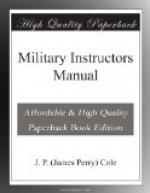CHAPTER 12.
Guard Duty.
Time spent: Study, 2 hours.
Conference,
2 hours.
Formal
guard mounting.
Guards are divided roughly into four classes:
1. Exterior—(Which
come more properly under head of field service).
2. Interior—Their
purpose is to preserve order, protect property
and enforce police regulations.
3. Military Police—Also
treated of in field service.
4. Provost Guards—Used
in the absence of military police to aid
civil authorities in preserving order among soldiers
beyond the
interior guard.
Here we are concerned chiefly with interior guards. We shall make up a brief summary of what an officer must know and what he ought to teach his non-coms. and men. Also we shall touch upon the subject of guard duty as it has been changed by trench warfare.
An officer ought to have a good grasp of the following
subjects
relative to guard duty:
1. Guard mounting (both formal
and informal).
2. Posting reliefs.
3. Preparation and running
of rosters.
4. General orders—also
special orders at post No. 1.
5. Duties of the following
in reference to guard duty:
1.
Commanding officer.
2.
Officer of the day.
3.
Adjutant.
4.
Sergeant Major.
5.
Commander of the guard.
6.
Sergeant of the guard.
7.
Corporal of the guard.
8.
Musicians.
9.
Orderlies and color sentinels.
10. Privates
of the guard.
6. Compliments of the guard.
7. Prisoners: General.
Garrison.
Awaiting
trial.
Awaiting
result of trial.
How is an officer arrested? Can an enlisted man arrest him?
How is a non-com. arrested?
How is a soldier arrested?
How is a civilian arrested?
(See a.w. No. 68.)
An officer ought to-teach to his non-coms. as much of the above as is consistent with time and other demands; he ought to teach to his privates all that is necessary to the proper discharge of their duties in this connection.
FORMAL GUARD MOUNTING.—Here follow a few reminders that may help the reader to keep the ceremony in mind:
1. Weather conditions permitting, guard mounting takes place every day at the discretion of the C.O.
2. Tour of duty is 24 hours; there are 3 reliefs, 2 hours on and 4 hours off. No organization is detailed for guard duty more than once in 5 days if this can be prevented.
CEREMONY.—1. The band takes post, its left 12 paces to the right of where the right of the guard is to be.
2. Adjutant’s Call.—The Adjutant marches to the parade ground (Sergeant Major on his left) and takes post 12 paces in front of and facing the center of where the guard is to rest. The Sergeant Major continues on, marches by the left flank and takes post 12 paces to the left of the band and facing in the direction the line is to extend.




